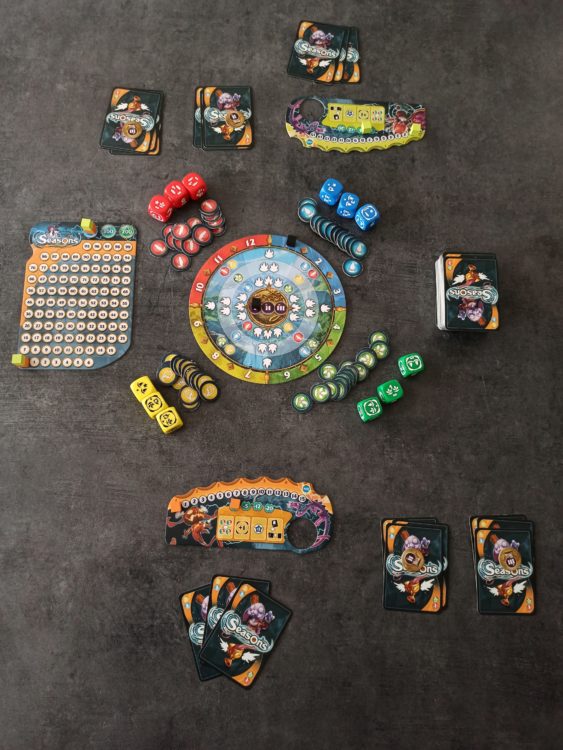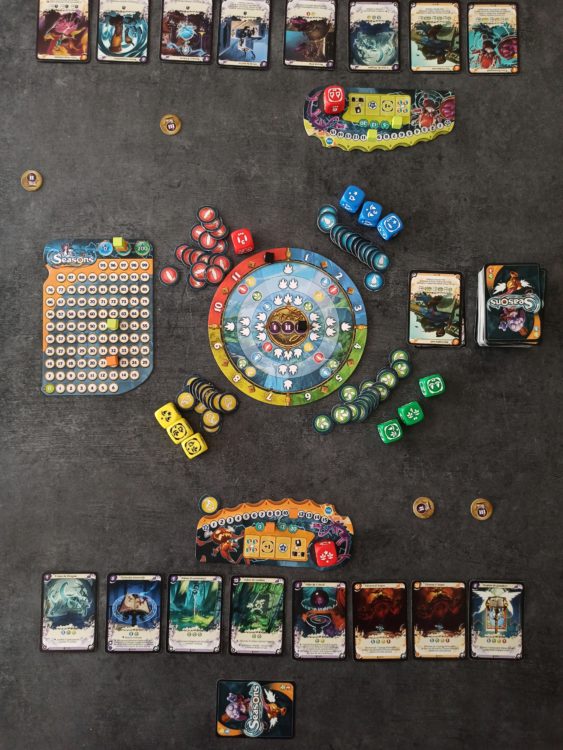
OBJECTIVE OF SEASONS: The objective of Seasons is to get more crystals than other players using season dice and power cards.
NUMBER OF PLAYERS: 2 to 6
MATERIALS:
- 1 game board, called the wheel of seasons
- 1 scoreboard, called the crystal track
- 4 personal boards (1 per player)
- 4 types of energy tokens: water, earth, fire and air.
- 20 season dice, 5 per season
- 16 coloured wizard cubes (4 per player)
- 2 black cubes (marker of seasons and years)
- 50 power cards
- 8 Library tokens (2 per player, for years II and III)
TYPE OF GAME: cards-with-dice management game
AUDIENCE: teen, adult
OVERVIEW OF SEASONS
In Seasons, each player plays the role of a wizard in a major tournament spread over three years. During each season, the wizards will have to make the most of the elements to summon powerful magical objects or familiars that will help them to obtain the most crystals, in order to become the most famous wizard.
With each season, the available dice change, forcing players to adapt and plan their strategy in advance, choosing the right time to play or activate their power cards.
SETUP
Place the game board in the centre of the table, then place the year marker cube on the Year 1 square in the centre of the board, and the season marker cube on the Year 1 square of the season wheel.
Place next to the board :
- as many dice of each colour as players +1
- the crystal track
- the energy stock
Each player takes an individual board, 2 library tokens and 4 sorcerer’s cubes of their colour, and places the cubes as follows:
- one on the zero square of the crystal track
- one on the zero square of the hundreds, at the top of the crystal track.
- one on the zero square of his bonus track, on his board
- one on the zero square of its summoning gauge
Deal out 9 face-down cards per player, and place the remaining cards near the board to make up the draw pile.

GAMEPLAY
Draft and strategy building
Choice of 9 power cards
- Each player consults the 9 power cards that have been dealt to him, then chooses one and places it face down in front of him.
- Each player places the remaining 8 cards face down in front of their left hand neighbour.
- Each player then chooses a new card from the 8 cards passed by his neighbour, and passes the others to his neighbour, and so on until each player has chosen 9 cards.
- From the 9 power cards chosen, each player makes up 3 packs of 3 cards. He then takes the first deck in hand, and places the second and third decks of cards under the Library II and III tokens, face down. These cards will be recovered by the player at the beginning of years 2 and 3.
The youngest player is the first player.
Start of the round
The first player takes the dice of the seasons corresponding to the current season, indicated by the season marker, and throws them. Starting with the first player, then taking turns clockwise, each player then chooses a dice and places it in front of him. The remaining dice is kept, it will indicate at the end of the round the number of squares to move the season marker.
The players’ turn
The first player performs his actions during his turn:
- Carry out the actions of his season dice.
- summon one or more of his power cards.
- Activate one or more of his power cards.
- Use one or more bonuses from his individual board.
Then each players plays his entire turn, in clockwise order.
End of the round
When all players have chosen their dice and resolved their actions, the season marker is advanced by a number of squares equal to the points on the remaining die (the one not chosen by any player).
If the season marker goes beyond square 12 (late autumn), the year marker is moved one square forward on the year scale. Players then take the power cards they had placed at the beginning of the game under the library token corresponding to the current year.
The left-hand neighbour of the first player becomes the first player, and a new round begins. He rolls the dice for the season indicated by the season marker on the season wheel.
The dice of the seasons
- Energy symbol (air, water, earth, fire): receive for each symbol an energy of the indicated type and place it in your reserve, if it’s not full.
- Number: Receive as many crystals as the number indicated, thus moving your wizard cube on the crystal track.
- Four-point circle: you can crystallize during the turn.
- Star: Increase your summoning gauge by 1 (move the wizard cube on your board).
- Card: Draw a power card from the deck.
- Points: At the end of the round, the season marker will advance as many squares as there are points on the remaining die.
The actions “receive energies” and “receive crystals” from the season dice must be performed before doing any other action. The other actions on the season dice may or may not be performed at any time during the player’s turn.
The energies
There are four types of energy:
- water: blue drop symbol, associated with winter
- earth: green leaf symbol, associated with spring
- fire: yellow flame symbol, associated with summer
- air: red feather symbol, associated with autumn
Crystallizing energies
During his turn, a player can, if he has a die that allows him to do so, crystallise energies from his reserve to transform them into crystals. The number of crystals obtained per crystallised energy depends on the rarity of the energy at the time it is crystallised.
Table of energy scarcity according to season
| common | unusual | rare | |
| Winter | water/air | fire | earth |
| Spring | earth/air | air | fire |
| Summer | earth/fire | earth | air |
| Autumn | fire/air | water | water |
| Crystals obtained | 1 | 2 | 3 |
Note: other effects, such as one of the bonuses, or certain cards, also allow you to crystallize energies, sometimes at a different conversion rate.
Power cards
In addition to earning victory points at the end of the game (shown at the top left of the card), power cards have many effects on the course of the game. In order to be able to use their effects, they must be summoned, i.e. be put into play. In order to summon a power card, you must:
- pay its summoning cost, by discarding the type and number of energies and/or crystals indicated just below its image (some cards have a varying cost depending on the number of players)
- have a sufficient summoning gauge to summon them: the value of the summoning gauge corresponds to the total number of power cards a player may have in play (if a player has a 3 gauge and 1 power card in play, he may still summon 2 more power cards)
Once all these criteria have been met, the power card is placed in front of the player and considered to be in play. It is recommended to read the effect(s) of the card to the opponents. These effects are indicated at the bottom of the card, under its summoning cost.
The visible background colour on the power cards represents their type: purple for magical objects, orange for familiars.
The different types of effect of the power cards, visible at the bottom left of each card, are as follows:
– Arrival effects in the game: represented by a downward pointing arrow, this effect is triggered only once, only when the card has just been summoned.
– Permanent effects: represented by a circular arrow, this effect lasts for the whole game, automatically, as long as this card remains in play.
– Activation effects: represented by a gear, this effect is only triggered when its owner decides to activate it during his turn. A player can only activate the effect of a card once per turn, after it has been summoned. Two conditions must be met:
- Tilt the power card at 90 degrees, which will only be straightened at the beginning of the next round. A card that has already been tilted cannot therefore be used in the same round (unless it also has a permanent effect, which remains active no matter what happens).
- Pay the cost of activating the effect, if one is indicated in the text of the effect (usually by discarding energy, crystals, or sacrificing another power card). If a player cannot pay this cost, they cannot use the item.

Bonuses
Bonuses offer the player additional benefits but cost prestige points at the end of the game. There are 4 different bonuses:
- Transmutation: allows to exchange any 2 energies from your reserve for 2 energies of your choice from the main reserve.
- Crystallization: Allows you to crystallize energies from your reserve at a higher rate. The energy conversion rate depends on the season, but with this bonus the player wins an extra crystal for each energy crystallised. For example, an energy of fire, normally crystallised in spring for 3 crystals, crystallises into 4 crystals thanks to this bonus.
- Power master: increases your summoning gauge by 1.
- Seer: allows you to use the “draw a card” action of a season die in an improved way: the player draws 2 power cards, takes one in his hand and discards the other.
When a player uses a bonus, he advances his wizard cube on his bonus track by one square. At the end of the game, the square where the cube is located will indicate the penalty suffered by the player:
- -5 for one bonus used
- -12 for two bonuses used
- -20 for every three bonuses used
Remarks:
- a player can only use the bonus track 3 times (the bonus track has only 3 squares in addition to the starting square)
- a player can use the same bonus more than once (within the limit of the previous rule)
- a player can use several or all of his bonuses during the same round if he wishes to do so
END OF GAME
The game ends in the third year of play, as soon as the season marker crosses the 12th square of the season wheel. To determine the winner, each player counts:
- Its crystals
- The prestige points present on his power cards in play.
- his cards still in his hand, which causes him to lose 5 points each.
- the current penalty score indicated on his bonus track, if he has used bonuses

Enjoy! 😊
VARIATIONS
First games
To help you learning the game, do not go through the draft stage to choose the 9 cards at the beginning of the game. Instead, use the pre-built sets of cards proposed in the detailed rules.
Average level
Use the normal rules, but only use cards numbered 1 to 30, which are of medium complexity.
Expert level
Use all cards. Cards 31 to 50 are more complex, and allow you to make combinations that can be very effective.
FUN BLURB
Already year’s end and you haven’t seen the seasons go by? No problem. With Seasons, you’re going through three colourful, magical years.
- Comprehensive Guide to the Board Game Go (weiqi, baduk) - January 23, 2024
- Are Creative Suites Changing Gaming - October 30, 2023
- Crowning the Kings of Solitaire: GameRules Recognizes Solitaired and MobilityWare as top Solitaire Games - October 20, 2023